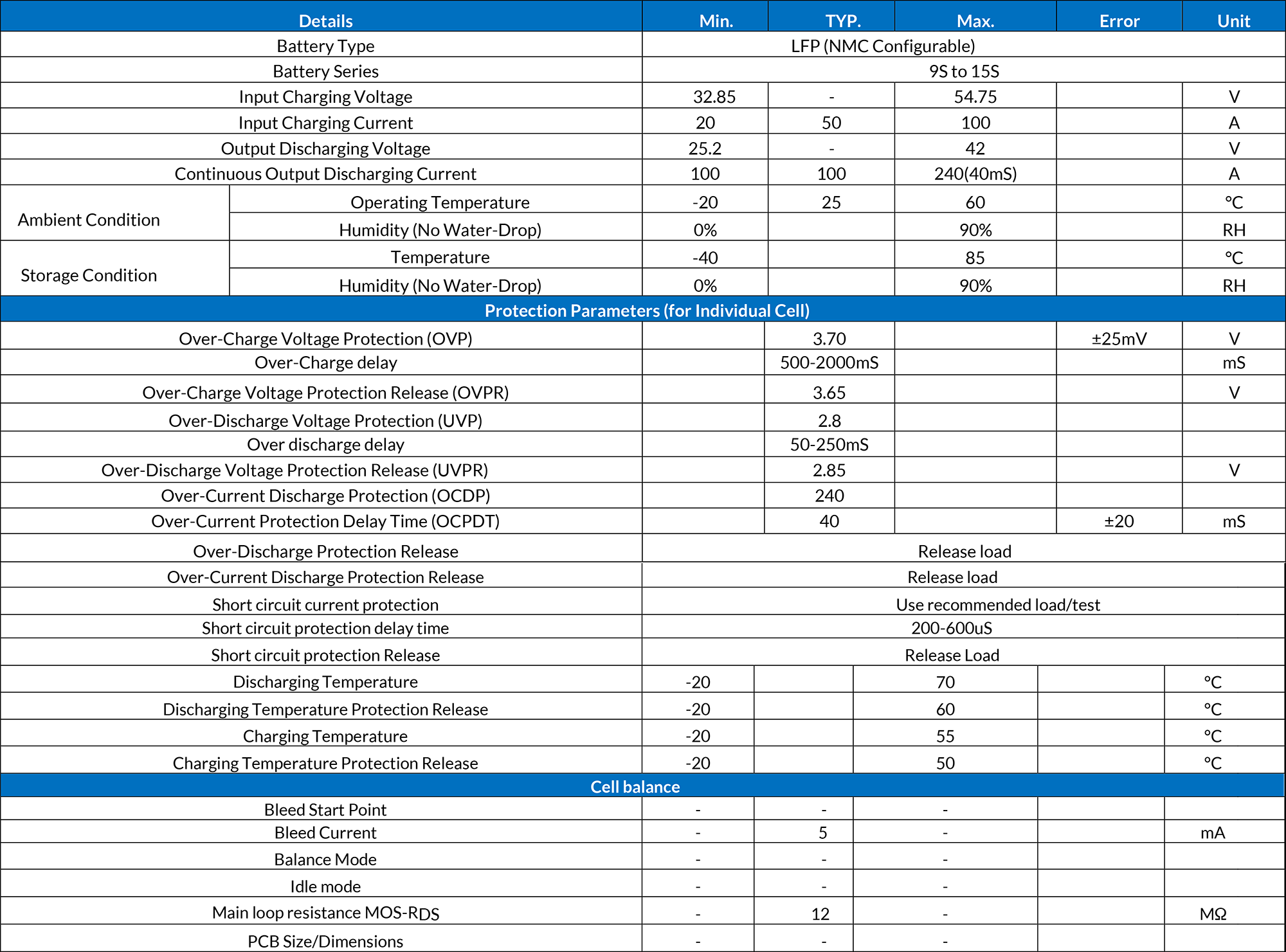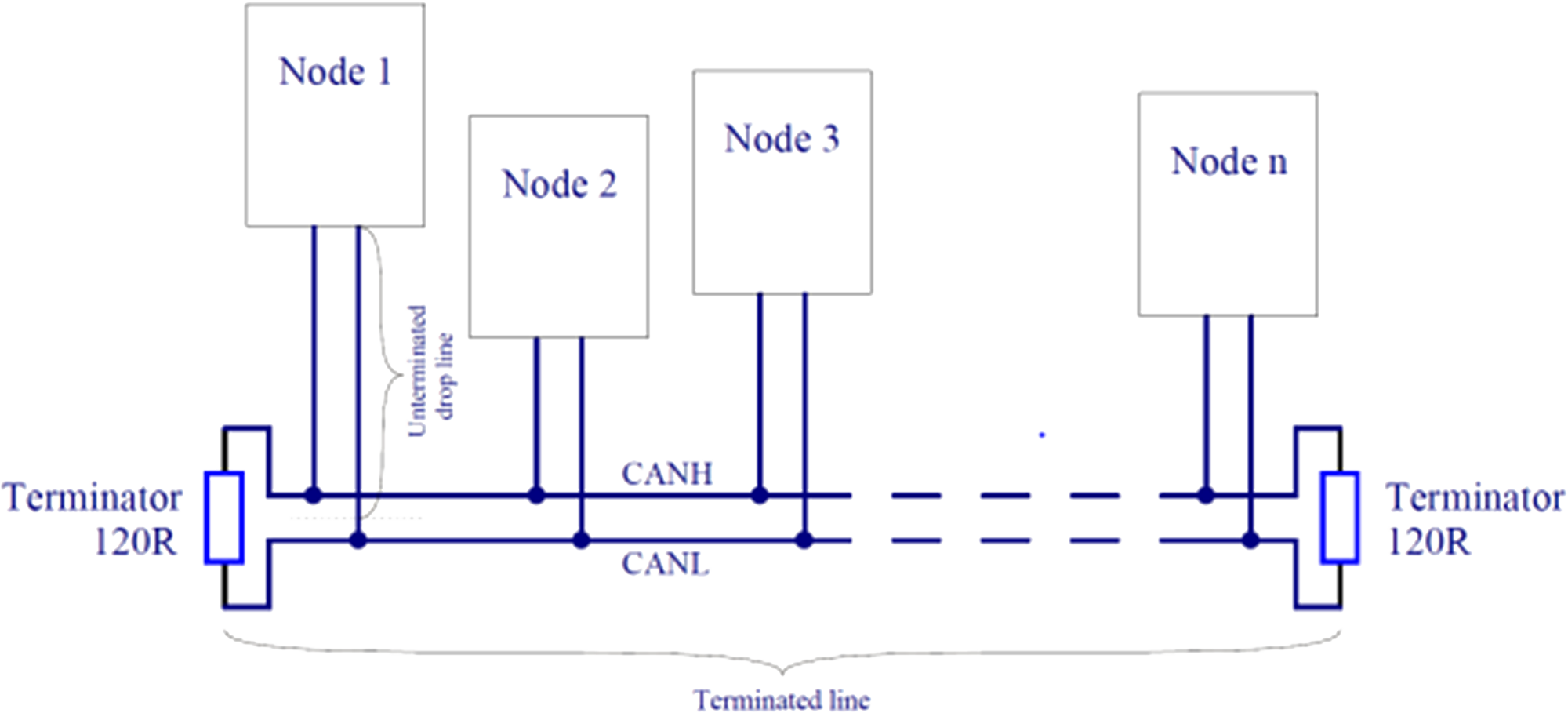9-15S BMS with Software/Communication
INNOLIA‘s nine-fifteen cell series Software/Communication BMS is designed for input voltage from 32.85V- 54.75V upto 100A with multiple optional add-on features including but not limited to Wi-Fi, Bluetooth, CAN, RS232, RS-485.
Electrical Features (Ta = 25c)

Functional Overview
Cell Monitoring
Individual cell monitoring is a fundamental and one of the most important functions of BMS. It is a complex, multi-part process in which certain roles are distributed between Cell Modules and the Control Unit. Each Cell Module, once mounted on a cell, starts its work routine during which it measures the cell’s voltage and its own temperature (as well as the external temperature, if applicable), and uses the measured values to regulate the balancing current in an attempt to keep the cell’s voltage lower than the balancing threshold, while at the same time keeping its own temperature lower than a certain maximum value to protect itself from overheating.
Current measurement
The measurement of the battery current in BMS comprises continuous, executed processes. The Control Unit continuously measures the analog signals given by BMS Current Sensor using a high sample rate analog-to-digital converter peripheral, and periodically stores averaged measurement results for further processing. The averaging is needed in order to mitigate the effects of thermal, quantization and other noises.
SOC estimation
State of Charge estimation in BMS is mainly based on the coulomb counting technique, with few exceptions where the SOC value is adjusted by cell voltage in order to mitigate its drawbacks. The coulomb counting is done in sync with the current update process: every newly determined momentary current value is multiplied by the update period, and the result, regardless of its sign, is accumulated into volatile memory as Battery Charge value (in Ah). This value is later compared to “Capacity” configuration parameter value in order to determine the SoC expressed in percentage.
Cell Balancing
“Balancing” stage is entered when the maximum cell voltage is more than or equal to the “Fully Charged Voltage” parameter value. At this point, the difference in stored energy between the cells is proportional to the difference in their voltages, therefore during this stage BMS takes several actions to eliminate that difference and balance them. Firstly, the balancing threshold is by default equal to” Fully Charged Voltage” parameter value as well, therefore the corresponding Cell Module(s) naturally start to divert the charging current through their shunt resistors in attempt to prevent the cell voltages from rising further. Secondly, the charging current is also controlled respect in to similar criteria; however, this process differs depending on what type of charging device is used.
Battery Protection
BMS protects the battery from operation beyond certain limits of its parameters (voltage, temperature, current) by deactivating the general-purpose output pin function. This pin function is intended for disconnection of battery from the load.
Hardware Protection Features
- Cell Under-Voltage protection prevents the battery from being discharged further if the voltage of at least one of the cells is below the threshold set by the corresponding “Activate at” parameter;
- Cell Over-Voltage protection prevent the cells from being overcharged during regenerative processes, and is activated if the voltage of at least one of the cells is above the threshold set by the corresponding “Activate at” parameter;
- Discharge Over-Current protection is activated if the measured discharge current is above the threshold set by the corresponding” Activate at” parameter, thus preventing the battery from being discharged at a rate that is higher than specified by the cell manufacturer;
- Charge Over-Current protection disconnects the main contactor if the measured charge current is above the threshold set by the corresponding” Activate at” parameter, thus preventing the high currents during regenerative processes from potentially damaging the cells;
- Cell Module Over-Heat protection prevents the battery from being operated when the temperature measured by the internal cell module’s temperature sensor is above the threshold set by corresponding” Activate at” parameter, which is likely to be caused by sparking/bad contact, an equipment failure, or a bad cell;
Battery Parameter Monitoring
- Pack Voltage
- Charging/Discharging Current
- SOC/SOH
- Battery Pack details
- BMS protection Parameters
- Individual string voltages
- Temperature of pilot cells
Communication Features
RS485
- 12Mpbs data rate
- Low power transreceiver
- Half duplex configuration
- All transmitter Outputs and receiver Inputs are protected to ±15KV
- Low Current 1µA in sleep mode
- Current limiting and thermal shutdown for driver overload protection
RS232
- 3.0V to 5.5V power supply
- 120Kbps data rate
- Enhanced ESD specifications:
- ±15kV Human Body Model
- ±15kV IEC61000-4-2 Air Discharge
- ±8kV IEC61000-4-2 Contact Discharge
CAN Bus
-
- 1Mbps data rate
- Very low standby current 5µA
- Protection Against Damage Due to Short-Circuit Conditions (Positive or Negative Battery Voltage)
- Automatic thermal shutdown protections
- High-Noise Immunity Due to Differential Bus Implementation
- Temperature range:
- Extended (E): -40°C to+125°C
- High (H): -40°C to+150°C
- Communicate with other CAN-equipped BMS components
- Control certain third-party charging devices
- Transmit BMS activity data (either periodically or by request)
- Receive new configuration parameter values and other special messages

Wi-Fi
- Wi-Fi protocols – 802.11b/g/n
- Frequency range – 2.4 GHz ~ 2.5 GHz (2400 MHz ~ 2483.5MHz)
Hardware features
- Peripheral interface – UART/HSPI/I2C/I2S/IR Remote-control
- Operating temperature range –40 °C ~ 85°C
Software features
- Wi-Fi mode Station/SoftAP/SoftAP +Station
- SecurityWPA/WPA2
- Network protocols IPv4, TCP/UDP/HTTP/FTP
Bluetooth
Hardware features
- Typical -80dBm sensitivity
- Up to +4dBm RF transmit power
- Low Power 1.8V Operation, 1.8 to 3.6V I/O
- UART interface with programmable baud rate
Software features
- Supported baud rate:9600-460800
- Auto-connect to the last device on power as default
- Auto-reconnect in 30 min when disconnected beyond the range of connection